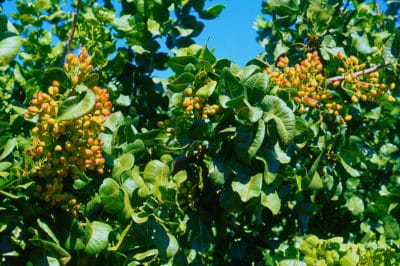More about Pistachio Trees
Mature pistachio tree can reach up to 35 feet tall with a similar spread. Trees are either male or female; both are required to produce a crop. Their physical characteristics include:
- Leathery, deep-green compound leaves measuring 4 to 8 inches long with three to five rounded leaflets.
- Dense clusters of tiny, greenish-brown flowers that bloom in early spring. (The flowers have no petals.)
- Gray bark that darkens and cracks as it ages.
- Dense umbrella canopies. They make pistachios excellent shade trees.
But the trees’ most important feature is their unusual fruit. As members of the Cashew (Anacardiaceae) family, pistachio trees produce clusters of fruit resembling miniature mangoes. Each mini-mango hanging from the ends of their branches contains a single seed. The seed is what we commonly call a pistachio nut — but a true nut is something quite different.
Pistachios Trees Are Fruit Trees
Why is a pistachio not a true nut? The answer lies in the way it peeps out from inside a shell that opened while still on the tree. The shells of true nuts never open without outside help. Acorns, beechnuts and hazelnuts are true nuts; pistachios are the seeds of fruits known as drupes.
What Are Drupes?
Drupes are fruits with pulpy flesh surrounding a hard shell that holds a single seed. Some drupes, such as apricots, peaches and plums, are grown for their sweet, juicy pulp. Pistachios, almonds, cashews and walnuts are drupes grown for their seeds.
Expert gardener’s tip: A layer of mango-scented, reddish-purple pulp covers each pistachio seed, but there’s too little to bother eating.
Small Nuts, Big Effort
Every pistachio began as a flower bud in the early spring of one year and wasn’t harvested until the late summer or early fall of the next. Growing it required:
- The right combination of winter chilling hours and summer heat so the trees could flower and fruit.
- Forty to 50 gallons of water per tree per day while the nut kernels developed.
- Enough wind to carry pollen between compatible male and female trees.
And that’s just some of the effort behind every tiny, delectable pistachio nut!
